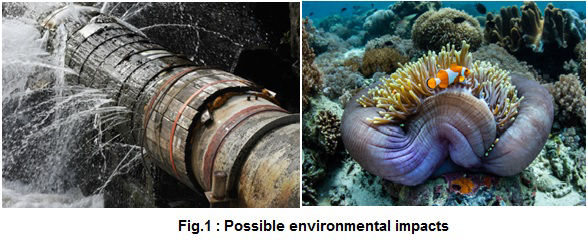
We haven't done any detailed site-specific environmental impact analysis. The below- listed impacts are the possible environmental impact that may happen because of our project. We considered the impacts from Solar, Wind, and Pumped hydro. In addition, we are suggesting some of the mitigation techniques that can be implemented to avoid the impacts.
Since the island of Cumbrae already got permission from the government to install PV, we assumed that the impacts assessment because of the PV is already taken place, and there are no environmental issues has been identified.
Some of the major challenges that we considered for the seawater pumped hydro is given below (shown in figure 1). It is based on the Okinawa island case study[1][2].

1. Impact due to Seawater leakage
One of the main concerns with seawater pump hydro storage type is the effect on vegetation and animals caused by bringing saltwater inland. The leakage from the penstock or from the machines could affect the environment and species.
2. Impacts on Marine life
Since this water pumped-storage hydro plant interacts directly with the ocean, high discharge flow rate (outlet) could affect marine life. As a result, engineers needed to find a way to limit its impact on marine life.
3. Corrosion challenge on equipments
In the long term, using saltwater for the circulation system can potential result in corrosion of pump hydro system equipment such as the pile and the turbine. Therefore, maintenance cost is likely to increase when the system operates in the long period unless some appropriate actions are applied to minimize this issue.
The below mitigation techniques are based on the Okinawa case study[1][2]
1.To prevent leakage of salt water into the surrounding environment in Okinawa, engineers included a rubber lining on the upper reservoir made from ethylene propylene diene monomer. In case the rubber lining fails, drainage pipes are equipped with seawater detectors and pressure gauges to alert system operators to salt water infiltration. If salt water leakage is detected, the pump system can be used to pump the salt water up through the drainage pipes back into the upper reservoir.
2. According to Okinawa island, they built the discharge outlet in the immediate area with the least coral development. Then, to reduce the velocity of water reentering the ocean, and therefore the impact on the local ecosystem, engineers built a breakwater of concrete blocks around the outlet. This limits the discharge velocity to approximately 10 centimeters per second
3. Fiberglass reinforced plastic (FRP) was used for the penstock – the pipe that carries water from the intake to the turbine – which prevents corrosion from seawater as well as the adhesion of marine organisms. These factors would otherwise decrease the system’s longevity and lower its efficiency. The generating turbine is made from austenite stainless steel, found to be the most anticorrosive of the stainless-steel options tested.
Some of the possible impacts due to wind turbine at the Cumbrae are
1. Land use and visual impacts
Finding a suitable land with less visual impact on the surrounding area is one of the main challenges. However, In general, wind turbines do not occupy very large of the land; they must be spaced approximately 5 to 10 rotor diameters apart (a rotor diameter is the diameter of the wind turbine blades). Thus, the turbines themselves and the surrounding infrastructure (including roads and transmission lines) occupy a small portion of the total area of a wind facility[3].
2. The effect due to sound on public health and community
Most of the sound generated by wind turbines is aerodynamic, caused by the movement of turbine blades through the air. There is also mechanical sound generated by the turbine itself. Overall sound levels depend on turbine design and wind speed[4]. The people living close to wind facilities could complain about sound and vibration issues.
In order to avoid these problems, we considered wind turbine of low height (not exceed 50 meters), and the minimum distance from the community to the turbines is 1 km.